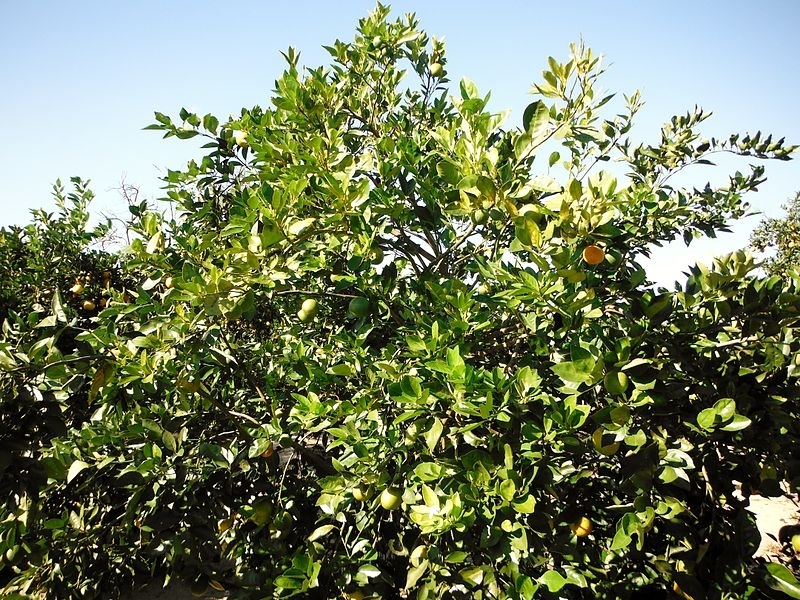

Two products based on human decongestant have been developed by Brazilian startup and proved effective in managing CVC, citrus canker and greening (photo: Wikimedia Commons)
Two products based on human decongestant have been developed by Brazilian startup and proved effective in managing CVC, citrus canker and greening.
Two products based on human decongestant have been developed by Brazilian startup and proved effective in managing CVC, citrus canker and greening.

Two products based on human decongestant have been developed by Brazilian startup and proved effective in managing CVC, citrus canker and greening (photo: Wikimedia Commons)
By Elton Alisson | Agência FAPESP – An anti-oxidant molecule called N-acetylcysteine (NAC), used in human health as a mucolytic or “cough syrup” to clear the airways, has resulted in the development of products that effectively control crop diseases such as citrus variegated chlorosis, citrus canker, and citrus greening or Huanglongbing (HLB).
In field tests, both plants with CVC and healthy plants treated with NAC-based products bore larger amounts of fruit and fruit with larger diameters than plants not submitted to the same treatment, said Simone Picchi, founder of CiaCamp, a startup located in São Paulo State, Brazil, that developed the products with support from FAPESP’s Innovative Research in Small Business (PIPE) program.
“The first field tests were performed by Helvécio Della Coletta Filho, a researcher affiliated with the Sylvio Moreira Citriculture Center, in plants that were severely affected by CVC during a period of drought in São Paulo, and the results were highly positive,” Picchi said in a presentation delivered at the event “From Basic to Applied Research: FAPESP's Support for Citriculture Research,” held in November 2016 in FAPESP’s auditorium.
“We believe similar results may have been obtained in other states, such as Sergipe, which, unlike São Paulo, hasn’t yet gotten CVC under control,” she added.
Picchi had the idea of developing the products after completing postdoctoral research on bacterial biofilm in 2010 under the supervision of researcher Alessandra Alves de Souza at the National Science & Technology Institute of Genomics for Citrus Breeding (INCT Citrus), one of the INCTs funded by FAPESP and the National Council for Scientific & Technological Development (CNPq). Both INCT Citrus and the Sylvio Moreira Citriculture Center are located in Cordeirópolis, São Paulo State. The Center is attached to the state’s Agronomy Institute (IAC).
At the time, Souza was studying NAC as a possible weapon in the fight against CVC.
During the whole-genome sequencing of Xylella fastidiosa, the bacterium that causes CVC, in 1999 – which was funded by FAPESP’s Genome Program – the Center’s researchers discovered that after infecting a citrus plant, X. fastidiosa forms a biofilm that accumulates in the host’s xylem vessels, preventing them from conducting water and minerals upward from the roots.
Based on this finding, Souza decided to test whether NAC could break down the biofilm at the start of its formation, both combating the disease and unblocking the xylem to allow water and minerals to flow again.
The results were positive, encouraging Picchi to test the use of NAC to combat Xanthomonas citri subsp. citri, the bacterium that causes citrus canker, during her postdoctoral research at the Center. “We observed that NAC is also effective in reducing citrus canker,” she said.
Picchi then licensed the patent allowing NAC to be used for the control of crop diseases at the Center and founded CiaCamp.
Through FAPESP’s PIPE program, she investigated the inclusion of NAC in alternative products for the management and control of bacterial citrus diseases. This resulted in two NAC-based products: one for spraying and the other for application to a plant’s roots as a fertilizer.
“NAC has a number of advantages: it’s a small molecule that’s easily absorbed, it can be combined with others to boost its action, and it doesn’t cause resistance in bacteria. It’s also biodegradable, so it doesn’t harm the environment,” Picchi said.
Field testing
According to Picchi, who was assisted by researcher Coletta Filho, the sprayable product, NAC Solution, was tested in the field on plants with citrus canker and HLB. The fertilizer, NACagri, was tested on plants with CVC and citrus canker.
“Plants with CVC treated with the fertilizer produced 14 kg more fruit than untreated plants with CVC,” Picchi said.
When plants with citrus canker were treated with the spray, the disease receded to the same extent as in plants treated only with copper.
“We don’t yet have the results of the product’s application for a complete crop cycle, but over a few months, it appears to have been as effective as copper, suggesting it may be an environmentally friendly alternative,” Picchi said.
The researchers are conducting citrus canker control tests on plants with and without symptoms to evaluate NAC’s effectiveness as an anti-oxidant to combat biotic stress (caused by living organisms) and abiotic stress (due to environmental factors, among others) in healthy plants.
“We know the product is effective even in healthy plants, so it may also mitigate stress and help the plant acquire greater resistance,” Picchi said.
The next step, she added, will be to continue field tests during two complete crop cycles to calibrate dosages and the ideal number of applications of both products in preparation for the start of sales in 2018.
She also plans to evaluate the effects of NAC on ten other types of bacteria that cause disease in other crops, such as coffee, soybeans and tomatoes.
Republish
The Agency FAPESP licenses news via Creative Commons (CC-BY-NC-ND) so that they can be republished free of charge and in a simple way by other digital or printed vehicles. Agência FAPESP must be credited as the source of the content being republished and the name of the reporter (if any) must be attributed. Using the HMTL button below allows compliance with these rules, detailed in Digital Republishing Policy FAPESP.





